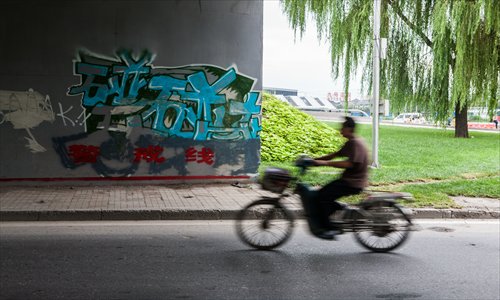
The red "guard line" under Sihui Bridge, Chaoyang district is concealed by graffiti on Sunday. The line is meant to warn drivers of flooding. Photo: Li Hao/GT
Graffiti has obscured warning lines painted under bridges or near low-lying land which indicate water levels in case of flooding, putting drivers' lives at risk, Beijing government has said.
However, Beijing drivers told the Global Times that the horizontal red lines, which were painted under bridges after the July 21 rainstorm and do not indicate water depth, are next to useless, while local government departments seem to be unsure whose responsibility it is to clean up the graffiti.
Graffiti was found painted above one such red line on an underpass on the southeastern side of Sihui Bridge, East Fourth Ring Road, the Beijing Morning Post reported on Friday. Above the line are three Chinese characters painted in red, which translate as "guard line."
Beijing municipal government posted on its Sina microblog Friday that since the lines are to warn drivers about the height of the water accumulated under bridges in case of heavy rain, this behavior poses a potential threat to public security.
The Global Times found the red line in the underpass at Sihui Bridge is painted 27 centimeters above the ground; however there is nothing to indicate at what height the line is, nor any other warning signs at the underpass to warn of a potential flood threat. If water were to cover the red line, there would be no way to tell what depth it was.
Twenty-seven centimeters is around the same height as the exhaust pipe of many vehicles, the Beijing Morning Post reported.
According to a Beijing Environment and Sanitary Regulation issued in 2002, painting or posting advertising and slogans in public areas is prohibited. Anyone caught doing so could be fined from 100 to 10,000 yuan ($15.7-1,575), depending on the severity of the damage, the report said.
Yet despite this regulation, Wang Qingwen, media officer of the Municipal Commission of City Administration and Environment, said that dealing with graffiti is not its responsibility.
"You should ask the Beijing Water Authority or the city administration bureau instead," he said.
A female employee, who refused to be named, from the Municipal Bureau of City Administration and Law Enforcement, said that it is only responsible for regulating illegal advertising in public areas or any content with commercial interests.
"Since the graffiti that you're talking about contains no commercial information, we aren't responsible for cleaning it up," she said. Yet she later said that the bureau would send staff to Sihui Bridge to check if it falls under their remit or not.
Zhou Dacheng, who works for a real estate company, has seen the guard lines being painted on some underpasses as he drives to work.
"This is really the cheapest measure the city could think of," he said, "besides, I don't think it really works as drivers won't be able to see it clearly under these dark bridges, especially at night," he said.
"But why are the underpasses flooded in bad weather anyway? They should improve the drainage system instead of doing these cheap paintings," Zhou remarked.
Zhu Tao, a traffic expert from Beijing University of Technology, said that the lines were painted to show residents that the government had acted after the severe flooding on July 21.
"It's just like when pedestrian crossings are marked out, but whether anyone pays any attention to them is another matter," he said.
But Zhu said he could not think of a better idea to warn drivers of the depth of floodwater.
Graffiti artist Jade Yip admitted that although it is not right to paint graffiti under bridges or anywhere without permission, there is a dilemma for graffiti painters.
"They don't do it just to break the law, they do it because they want to find a great public area that everybody gets to see," she said.
"The reason why there's a lot of graffiti under bridges is because there's a lot of space, and the painters won't get interrupted," said Yip.

Copyright ©1999-2011 Chinanews.com. All rights reserved.
Reproduction in whole or in part without permission is prohibited.